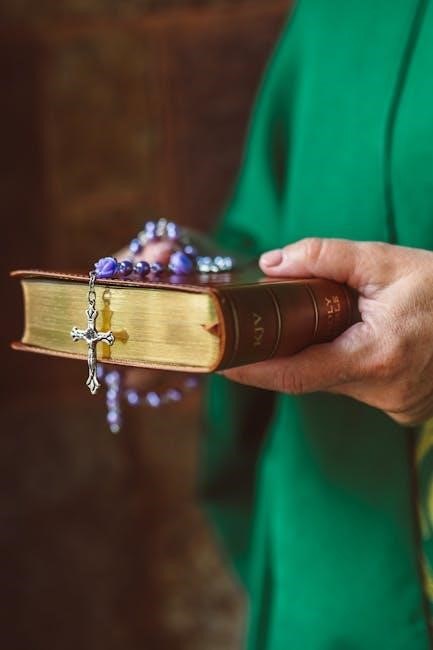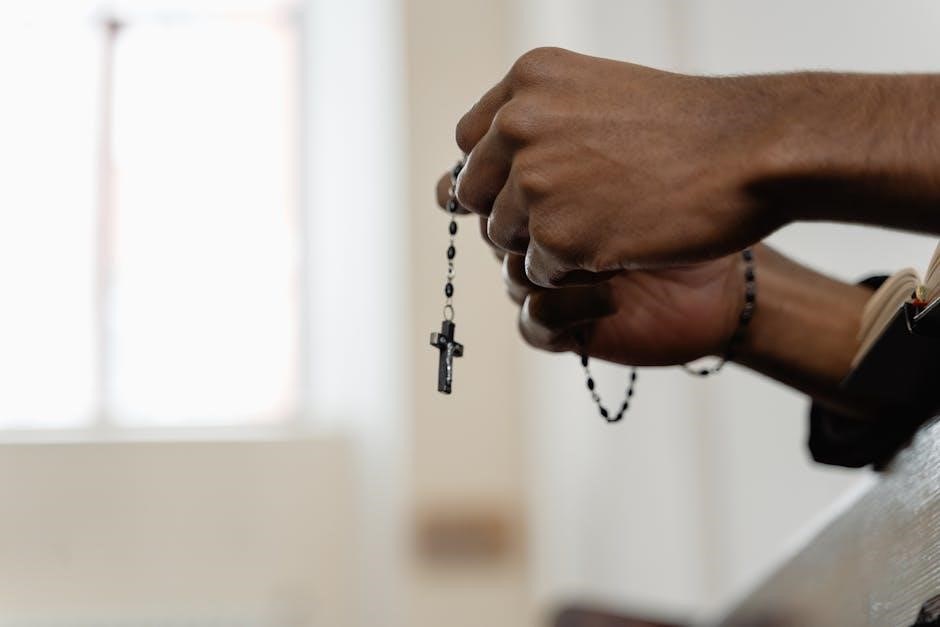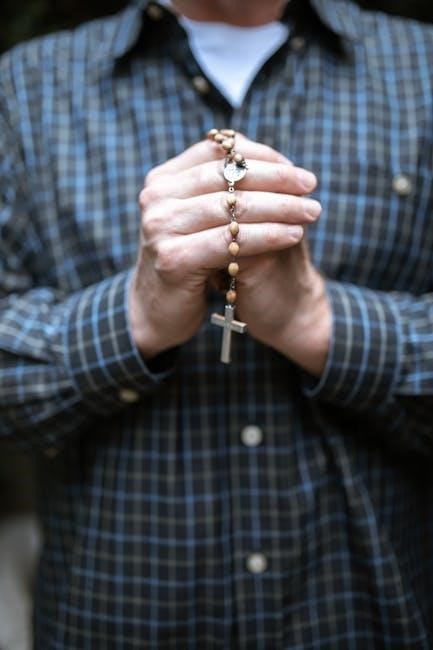
The Rosary Prayer for the Dead is a traditional Catholic devotion, offering solace to the grieving and spiritual support for the departed. It combines meditation and intercession, fostering a connection with the deceased and seeking eternal rest for their souls through prayer.
1.1 Overview of the Rosary Prayer
The Rosary Prayer for the Dead is a sacred Catholic tradition that combines meditation on the life of Christ and intercession for the deceased. It typically includes the Sign of the Cross, Apostles’ Creed, and the Glorious Mysteries, with specific prayers for the soul’s eternal rest. This prayer is often recited at funerals or private gatherings, offering comfort to the bereaved while seeking divine mercy for the departed. Its structure and intent make it a universal and enduring devotion in Catholic faith, emphasizing communal prayer and spiritual connection with the deceased.
1.2 Purpose of Praying for the Dead
Praying the Rosary for the Dead serves to assist the soul’s journey through purgation, seeking divine mercy and eternal rest. It reflects Catholic beliefs in the afterlife, offering spiritual support to the deceased. The prayer also brings solace to the grieving, fostering a sense of connection and hope. By praying for the dead, Catholics uphold the Church’s teachings on the communion of saints and the value of intercession. This practice emphasizes faith in God’s mercy and the power of prayer to aid souls in achieving eternal peace, aligning with the Catholic doctrine of purgatory and the importance of praying for the departed.

Historical Background of the Rosary for the Dead
The Rosary’s origins trace back to medieval Europe, evolving from prayer beads used by early Christians. Over centuries, it became a devotion to Mary, with mysteries reflecting Jesus’ life. The practice of praying the Rosary for the deceased emerged as a way to seek mercy and eternal rest for souls, rooted in Catholic teachings on purgatory and intercession. This tradition has been upheld through generations, becoming a cornerstone of Catholic funeral rites and devotions for the dead.
2.1 Origins of the Rosary
The Rosary’s origins can be traced to early Christianity, where prayer beads were used to count prayers. By the Middle Ages, this practice evolved into a structured devotion, often linked to Marian piety. The term “Rosary” comes from the Latin “rosarium,” meaning “garden of roses,” symbolizing prayers offered to Mary. The modern Rosary, with its familiar structure of decades and mysteries, emerged in the 15th century, influenced by Dominican friars. Initially used for personal meditation, it became a popular communal prayer, blending Scripture, devotion, and intercession. This historical foundation laid the groundwork for its use in praying for the deceased.
2.2 Evolution of the Rosary as a Prayer for the Deceased
The Rosary’s use as a prayer for the dead developed over centuries, blending traditional Marian devotion with intercession for souls. Initially a general meditation on Gospel events, it became linked to funeral rites and commemorations. The addition of prayers like the “Eternal Rest” and “De Profundis” reflected its evolving role in seeking mercy for the departed. By the 17th and 18th centuries, the Rosary was widely recited during novenas and anniversaries, solidifying its connection to the deceased. This adaptation emphasized its power to comfort the living while aiding the souls in purgatory, becoming a cornerstone of Catholic bereavement practices.

Structure of the Rosary Prayer for the Dead
The Rosary for the dead includes the Sign of the Cross, Apostles’ Creed, five Glorious Mysteries, and a sequence of prayers. It may also include additional prayers like the Eternal Rest and a final blessing for the deceased.
3.1 The Sign of the Cross
Making the Sign of the Cross is the opening gesture of the Rosary for the dead. It involves touching the forehead, chest, and shoulders while saying, “In the name of the Father, and of the Son, and of the Holy Spirit. Amen.” This sacred act invokes God’s protection and grace, dedicating the prayer to the deceased. It symbolizes faith in the Holy Trinity and serves as a reminder of Christ’s sacrifice. The Sign of the Cross sets a solemn tone, preparing the soul to intercede for the departed and seek divine mercy. Its simplicity and profundity make it a powerful beginning to the Rosary prayer.
3.2 Apostles’ Creed
The Apostles’ Creed is a foundational prayer recited after the Sign of the Cross in the Rosary for the dead. It professes the Catholic faith, affirming belief in God, Jesus Christ, and the Holy Spirit. The Creed serves as a solemn declaration of faith, emphasizing the resurrection of the dead and eternal life. By praying it, the faithful reaffirm their beliefs and intercede for the deceased, seeking divine mercy and forgiveness. This prayer bridges the living and the dead, uniting them in a shared hope of eternal rest. Its inclusion in the Rosary underscores its importance in Catholic tradition and devotion.
3.3 The Five Glorious Mysteries
The Five Glorious Mysteries are a central part of the Rosary for the dead, focusing on the triumph of Christ and the glorification of Mary. These mysteries include the Resurrection, Ascension, Descent of the Holy Spirit, Assumption of Mary, and her Coronation. Praying these mysteries offers hope and comfort, as they remind the faithful of eternal life and the promise of resurrection. They also honor Mary’s role as intercessor for the souls of the deceased. By reflecting on these glorious events, the praying community seeks divine mercy and eternal rest for the departed, strengthening their connection to the divine and the afterlife. This section is a powerful expression of Catholic devotion and hope.
3.4 Sequence of Prayers
The Rosary for the dead follows a structured sequence of prayers, beginning with the Sign of the Cross and the Apostles’ Creed. This is followed by the Our Father, three Hail Marys, and a Glory Be, which are repeated for each of the five decades. The Fatima Prayer is also included after each decade, specifically for the souls in purgatory. The sequence concludes with additional prayers, such as the Hail Holy Queen and the Prayer for the Departed. This structured approach ensures a meaningful and reverent devotion, offering comfort to the bereaved while honoring the deceased and seeking divine mercy for their souls. The sequence reflects Catholic tradition and the belief in the power of prayer for the departed.

Significance of the Rosary for the Dead
The Rosary for the Dead is a meaningful Catholic tradition that honors deceased loved ones, offers spiritual support, and provides comfort to the bereaved while seeking divine mercy.
4.1 Intercession for the Souls
Praying the Rosary for the Dead serves as a powerful intercession for souls in purgatory, seeking their purification and swift entry into eternal life. Through the Rosary, Catholics invoke Mary’s maternal intercession, believing her prayers are efficacious in assisting the deceased. The repetition of the Hail Mary, coupled with meditative reflection on the Glorious Mysteries, emphasizes the resurrection and eternal glory, offering spiritual solace to the departed. This practice reflects the Catholic belief in the communion of saints and the value of praying for the dead, providing a meaningful way to support loved ones on their final journey to heaven.
4.2 Comfort for the Bereaved
The Rosary for the Dead offers profound comfort to those grieving the loss of loved ones. Reciting the prayers, particularly the Hail Mary and Our Father, provides a sense of structure and routine, which can be calming during emotional turmoil. Reflecting on the Glorious Mysteries fosters hope in the resurrection, reassuring the bereaved of eternal reunion. The communal aspect of praying the Rosary, whether with family or in a group, strengthens bonds and shares the burden of sorrow. This sacred tradition becomes a balm for the grieving heart, blending faith with emotional healing and providing solace in times of loss.
4.3 Connection to Catholic Tradition
The Rosary for the Dead deeply roots itself in Catholic tradition, reflecting the Church’s belief in the communion of saints and the efficacy of prayer for the deceased. This practice aligns with Catholic doctrine on purgatory, where souls undergo purification before entering heaven. The Rosary’s structure, including the Hail Mary and Our Father, emphasizes devotion to Mary and the Trinity, central to Catholic faith. Praying the Rosary for the dead also connects to the tradition of offering Masses and novenas, reinforcing the Church’s teaching on the importance of intercession. This prayer tradition unites the faithful in a shared act of love and remembrance, bridging the living and the deceased in a bond of faith.

Role of Mary in the Rosary for the Dead
Mary, as the Mother of God, plays a central role in the Rosary for the Dead, serving as a powerful intercessor for souls. Her maternal love and guidance are believed to aid the deceased in their journey to heaven, while bringing comfort and solace to the bereaved. The Rosary’s focus on Mary’s life and mysteries deepens devotion to her, emphasizing her role as a spiritual mother to all, including the departed. This tradition reinforces Catholic teachings on Mary’s intercessory power and her connection to the souls in purgatory.
5.1 Mary’s Intercession
Mary’s intercession is a cornerstone of the Rosary for the Dead, as Catholics believe her prayers powerfully advocate for souls in purgatory. Through the Rosary, devotees seek her maternal intercession, trusting in her closeness to God and her compassion for the departed. The Hail Mary prayer, repeated throughout the Rosary, emphasizes her role as a mediator of grace and mercy. This practice reflects Catholic doctrine on Mary’s unique position as a spiritual mother, offering comfort to the grieving and hope for the deceased. Her intercession is seen as a bridge between the living and the dead, fostering spiritual healing and eternal peace.
5.2 The Hail Mary Prayer
The Hail Mary prayer is a central component of the Rosary for the Dead, serving as a heartfelt plea to the Virgin Mary for her intercession. The prayer begins with “Hail Mary, full of grace, the Lord is with thee,” acknowledging her divine role. It continues by asking Mary to pray for sinners, specifically mentioning the deceased, seeking her mercy and grace. In the context of praying for the dead, this prayer is often adapted to include a request for the souls in purgatory, emphasizing Mary’s maternal care and her ability to intercede on behalf of the departed. This prayer brings solace to the grieving and reinforces the Catholic belief in Mary’s mediatory role, connecting the living with the deceased through faith and tradition.

Novenas and the Rosary for the Dead
6.1 What is a Novena?
A Novena is a traditional Catholic devotion consisting of nine days of prayer, often seeking divine intervention or honoring a saint. It can be prayed for various intentions, including the repose of souls. In the context of the Rosary for the dead, a Novena involves reciting specific prayers over nine consecutive days, typically including the Rosary, to intercede for the deceased and assist their journey through purgation. This practice reflects Catholic belief in the power of prolonged, communal prayer to bring comfort and spiritual aid to both the living and the departed. Novenas deepen faith and foster a sense of community among participants.
6.2 Praying the Rosary for Nine Days
Praying the Rosary for nine consecutive days, known as a Novena, is a devout practice to honor the deceased and seek their eternal rest. Each day, the Rosary is recited, often with a focus on the Glorious Mysteries, emphasizing the resurrection and eternal life. The prayers are typically accompanied by reflections on the life of the departed and intentions for their soul. This extended period of prayer fosters a deeper spiritual connection and provides comfort to the bereaved. Many Catholics find solace in this tradition, believing it aids the soul’s journey through purgation and strengthens their own faith during grief.

How to Pray the Rosary for the Dead
Begin with the Sign of the Cross, recite the Apostles’ Creed, and pray the Rosary, focusing on the Glorious Mysteries. Conclude with prayers for the deceased, seeking eternal rest and peace for their soul.
7.1 Preparing for the Prayer
Before praying the Rosary for the dead, gather a Rosary beads and a prayer book or PDF guide. Find a quiet, reverent space to focus on the deceased. Light a candle or place religious symbols nearby to create a sacred atmosphere. Reflect on the deceased’s life and the intention of praying for their soul’s purification and eternal rest; Open your heart to seek comfort and grace through this traditional Catholic devotion. Ensure you have the necessary prayers printed or downloaded, such as the Apostles’ Creed, Hail Mary, and Our Father, to follow the structure seamlessly.
7.2 Step-by-Step Guide
Begin with the Sign of the Cross, invoking God’s blessings. Recite the Apostles’ Creed, expressing faith. Pray the Our Father and three Hail Marys, followed by a Glory Be. For each of the five Glorious Mysteries, announce the mystery, pray the Our Father, ten Hail Marys, and a Glory Be. Conclude with the Salve Regina and a final Sign of the Cross. Include the Fatima Prayer after each decade for the souls in purgatory. Use a Rosary beads to keep track of prayers. Follow a guide or printed PDF to ensure the structure is maintained and the prayer is offered meaningfully for the deceased.
7.3 Tips for Meaningful Prayer
To pray the Rosary meaningfully for the dead, create a quiet, reflective environment. Use a Rosary beads or guide to stay focused. Reflect on the Glorious Mysteries, connecting their triumph to the soul’s journey to heaven. Pray with intention, sincerity, and devotion. Include specific intentions for the deceased and their loved ones. Encourage mindfulness by pausing briefly after each prayer. Avoid distractions and maintain a steady pace. Pray with faith, trusting in Mary’s intercession. Consider praying aloud for clarity and emphasis. End with a heartfelt request for God’s mercy and peace for the soul. This ensures the prayer is both reverent and impactful.

PDF Resources for the Rosary for the Dead

Discover downloadable PDF guides offering prayers, mysteries, and instructions for the Rosary for the Dead. These resources provide structured formats for meaningful devotion and remembrance.
8.1 Available PDF Guides
Various Catholic websites and publishers offer downloadable PDF guides for the Rosary for the Dead; These resources typically include the structure of the prayer, the five Glorious Mysteries, and accompanying prayers like the Hail Mary and Our Father. Some guides also feature reflections, Scripture passages, and tips for meaningful prayer. They are designed to assist individuals or groups in praying for the deceased, offering a convenient and organized format. Many PDFs are free to download and can be easily shared via email or social media, making them accessible for widespread use. These guides are invaluable for those seeking to honor the departed through prayer.
8.2 Features of a Rosary Prayer PDF
A Rosary Prayer PDF for the Dead typically includes the full structure of the prayer, featuring the five Glorious Mysteries, the Hail Mary, Our Father, and other accompanying prayers. Many guides include reflections, Bible verses, and spiritual insights to deepen devotion. Some PDFs offer visual aids, such as diagrams of the rosary beads or images of sacred art, to enhance the prayer experience. They may also provide instructions for group or individual recitation, making them versatile for various settings. Additionally, some PDFs include optional prayers, such as the Fatima Prayer or the Salve Regina, to enrich the spiritual practice.
8.3 Where to Download
Rosary Prayer PDFs for the Dead can be easily downloaded from various Catholic websites and resources. Many Catholic churches and dioceses offer free downloadable guides on their official websites. Websites like the Vatican, EWTN, and Catholic.org provide authentic and detailed Rosary Prayer PDFs. Additionally, platforms like Google Play and the Apple App Store have Catholic prayer apps that include Rosary PDFs for the deceased. Some parishes and cathedrals also distribute these PDFs during funerals or special prayer services. Ensure the source is reputable to maintain doctrinal accuracy and authenticity.

Benefits of Praying the Rosary for the Dead
Praying the Rosary for the Dead offers solace, hope, and spiritual benefits, aiding the deceased’s soul while comforting the living and deepening faith.
9.1 Spiritual Benefits
Praying the Rosary for the Dead provides profound spiritual benefits, offering comfort to the deceased and strengthening the faith of the living. It assists the soul in their journey through purgatory, helping to purify their spirit and prepare them for eternal life. The Rosary’s prayers, particularly the Hail Marys and Our Fathers, are believed to intercede on behalf of the departed, earning them spiritual merit and relief from suffering. For the living, it deepens devotion, fosters a sense of connection to the deceased, and encourages reflection on the afterlife. This practice also nurtures a sense of community and shared faith among those praying together.
9.2 Emotional Healing
Praying the Rosary for the Dead brings emotional healing to those grieving, offering solace and peace during difficult times. The repetitive, meditative nature of the prayers creates a sense of calm, helping to ease sorrow and provide comfort. It allows mourners to process their loss while expressing love and remembrance for the deceased. The Rosary also fosters a connection to the departed, reducing feelings of isolation and loneliness. By focusing on the mysteries and prayers, individuals can navigate their grief in a structured, meaningful way. This practice provides a spiritual outlet for emotions, helping to heal the heart and find closure.
9.3 Communal Prayer Impact
Praying the Rosary for the Dead in a communal setting amplifies its emotional and spiritual benefits. Group prayer fosters a sense of unity and shared purpose, comforting mourners and strengthening their faith. The collective recitation of prayers creates a powerful expression of intercession, offering solace to both the grieving and the deceased. Communal prayer also reinforces the Catholic belief in the communion of saints, reminding participants of their connection to the larger Church community. This shared experience can deepen spiritual bonds and provide a sense of support during times of loss. It emphasizes the value of praying together for the departed.
The Rosary for the Dead is a profound tradition offering solace and spiritual aid. It honors the deceased while bringing comfort to the living through prayer.
10.1 Summary of the Rosary for the Dead
The Rosary for the Dead is a profound Catholic devotion offering solace and spiritual support for both the deceased and the grieving. It combines prayer, reflection, and meditation, traditionally using a rosary beads to guide the recitation of prayers like the Hail Mary, Our Father, and Glory Be. The practice often includes the Five Glorious Mysteries, which contemplate the resurrection and heavenly glory, symbolizing hope for the departed soul. Additional prayers, such as the Eternal Rest, are frequently added to seek divine mercy. This prayer not only aids the soul’s journey but also provides comfort to those mourning, reinforcing Catholic beliefs in intercession and eternal life.
10.2 Encouragement to Practice
Praying the Rosary for the dead is a profound act of love and faith, offering comfort to the bereaved while interceding for the souls. It strengthens spiritual bonds and deepens devotion to Catholic traditions. Embracing this practice fosters a sense of community, as many join in praying for the deceased. The Rosary’s repetitive prayers create a meditative rhythm, helping to process grief. By committing to this practice, one not only honors the dead but also nurtures their own spiritual growth. Encourage others to participate, as collective prayer amplifies its impact. Let the Rosary be a source of solace and a bridge to the afterlife.
Leave a Reply
You must be logged in to post a comment.